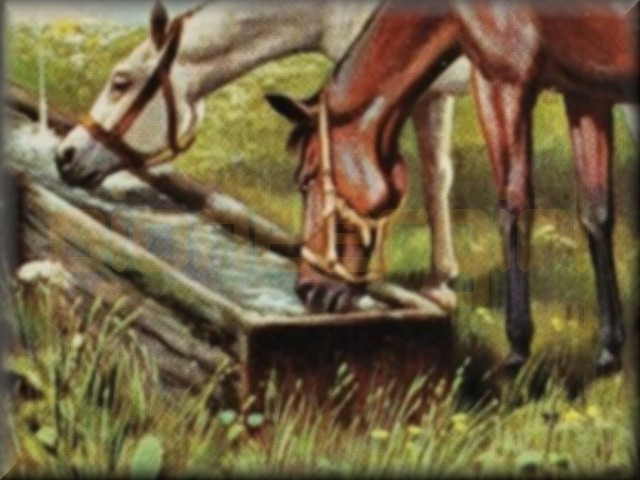trough

A long, hollow vessel, generally for holding water or other liquid, especially one formed by excavating a log longitudinally on one side; a long tray; also, a wooden channel for conveying water, as to a mill-wheel. Hence, a channel, receptacle, or depression, of a long and narrow shape; as, a trough between two ridges, and the like. — Webster, 1882
 The zinc baptismal tank from the Baptist church, located on the northwest corner of the school block and torn down around 1922 to make way for the High School building standing there today, became a horse watering trough on the H. O. Fritzel farmstead adjoining town and was used there for many years. – De Smet News, July 28, 1960
The zinc baptismal tank from the Baptist church, located on the northwest corner of the school block and torn down around 1922 to make way for the High School building standing there today, became a horse watering trough on the H. O. Fritzel farmstead adjoining town and was used there for many years. – De Smet News, July 28, 1960
 Unless the weather was prohibitive or there wasn’t a free-flowing creek nearby where Pa took his oxen or horses to drink — such as Walnut Creek in Indian Territory Kansas or Plum Creek in Walnut Grove, Minnesota — drinking water for livestock was supplied by filling a trough from which the stock could drink. At times when the Ingallses owned relatively few animals, the watering trough was filled by toting buckets of water from the creek or a well. This is in contrast to the Wilder family’s prosperous New York farm, where they owned so much livestock that water was pumped from a well-house pump to a large outdoor trough via a small wooden trough passing through the pump-house wall. It took young Almanzo quite a while to pump enough water to fill the huge trough and to keep it full while all the animals drank their fill from it.
Unless the weather was prohibitive or there wasn’t a free-flowing creek nearby where Pa took his oxen or horses to drink — such as Walnut Creek in Indian Territory Kansas or Plum Creek in Walnut Grove, Minnesota — drinking water for livestock was supplied by filling a trough from which the stock could drink. At times when the Ingallses owned relatively few animals, the watering trough was filled by toting buckets of water from the creek or a well. This is in contrast to the Wilder family’s prosperous New York farm, where they owned so much livestock that water was pumped from a well-house pump to a large outdoor trough via a small wooden trough passing through the pump-house wall. It took young Almanzo quite a while to pump enough water to fill the huge trough and to keep it full while all the animals drank their fill from it.
Although Mrs. Wilder writes about the Ingalls and Wilder families owning livestock in every Little House book, she only mentions watering troughs a handful of times in passing. They would have been so commonplace that almost all readers would have known what they were at the time the books were first published. When writing about the De Smet years, Wilder doesn’t mention watering troughs at all. She merely writes that men took their horses to “water at the well,” not going into detail as to whether they drank from a pail or from a trough filled via bucket with water drawn from the well. At the Ingalls Homestead today, there is a well with pump located between where the house and barn originally stood.

Pump with little trough at the Wilder Farm showing how water was sent from indoor pumphouse to large watering-trough in the enclosed barnyard.
Troughs hold liquid, while a manger holds dry feed. Watering troughs were originally made by hollowing out the center of a single large log, and by definition, any long narrow water-tight vessel became known as a trough simply because of its shape. Watering troughs were also constructed from wooden boards, cement, or metal. They could be supplied with a drain for ease in cleaning or merely tipped on their side to empty and clean. Most pioneer towns had a town pump and at least one town watering trough: television and movie westerns immortalized the watering trough as it was a common scene to have a character fall into the large watering trough after a fight or too much drinking, where he was thoroughly “cooled off” in the process. In De Smet’s early years, a town well was located just north of where the Ingalls building stood facing Calumet, later replaced by a town pump in the basement of Couse Hardware. The public watering trough was located on the south side of the hardware store on Second Street.
In Little Town on the Prairie (see Chapter 14, “Sent Home from School”), Wilder mentions the eraser trough, a the little wooden trough attached to the wall at the base of the blackboard, used to hold the eraser and sticks of chalk when not in use. This is what Carrie Ingalls grabs hold of to keep from falling after growing faint while writing at the blackboard. Although the original blackboards were revealed when the first schoolhouse in De Smet was renovated, the eraser trough had been removed. The photo here is of the restored Harvey Dunn schoolhouse, part of the Depot Museum complex in De Smet. You can see the chalk trough at the base of the blackboard on the wall; as all chalk trays, it has a routed depression running its length to keep the chalk from rolling off.

Blackboard with chalk trough at the Harvey Dunn school.

trough (BW 7; FB 5; LHP 10; BPC 20) see also manger
watering-trough (FB 5, 15)
little trough for channeling water (FB 5)
eraser trough (LTP 14)

